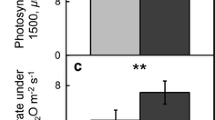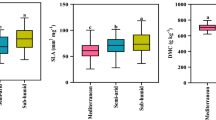Abstract
The presence of foliar variegation challenges perceptions of leaf form and functioning. But variegation is often incorrectly identified and misinterpreted. The striking variegation found in juvenile Blastus cochinchinensis (Melastomataceae) provides an instructive case study of mechanisms and their ecophysiological implications. Variegated (white and green areas, vw and vg) and non-variegated leaves (normal green leaves, ng) of seedlings of Blastus were compared structurally with microtechniques, and characterized for chlorophyll content and fluorescence. More limited study of Sonerila heterostemon (Melastomataceae) and Kaempferia pulchra (Zingiberaceae) tested the generality of the findings. Variegation in Blastus combines five mechanisms: epidermal, air space, upper mesophyll, chloroplast and crystal, the latter two being new mechanisms. All mesophyll cells (vw, vg, ng) have functional chloroplasts with dense thylakoids. The vw areas are distinguished by flatter adaxial epidermal cells and central trichomes containing crystals, the presence of air spaces between the adaxial epidermis and a colorless spongy-like upper mesophyll containing smaller and fewer chloroplasts. The vw area is further distinguished by having the largest spongy-tissue chloroplasts and fewer stomata. Both leaf types have similar total chlorophyll content and similar F v/F m (maximum quantum yield of PSII), but vg has significantly higher F v/F m than ng. Variegation in Sonerila and Kaempferia is also caused by combined mechanisms, including the crystal type in Kaempferia. This finding of combined mechanisms in three different species suggests that combined mechanisms may occur more commonly in nature than current understanding. The combined mechanisms in Blastus variegated leaves represent intricate structural modifications that may compensate for and minimize photosynthetic loss, and reflect changing plant needs.






Similar content being viewed by others
References
Arnon DI (1949) Copper enzymes in isolated chloroplasts. Polyphenoloxidase in Beta vulgaris. Plant Physiol 24:1–15
Campitelli BE, Stehlik I, Stinchcombe JR (2008) Leaf variegation is associated with reduced herbivore damage in Hydrophyllum virginianum. Bot 86:306–313
Cui WH, Guan KY (2013) Diversity of leaf variegation in Chinese Begonia. Plant Divers Resour 35:119–127
Davison GWH, Ng PKL, Ho HC (2008) The Singapore red data book: Threatened plants and animals of Singapore. Nature Society, Singapore
Esteban R, Fernádez-Marín B, Becerril JM, García-Plazaola JI (2008) Photoprotective implications of leaf variegation in E. dens-canis L. and P. officinalis L. J Plant Physiol 165:1255–1263
Fooshee W, Henny RJ (1990) Chlorophyll levels and anatomy of variegated and non-variegated areas of Aglaonema nitidum leaves. P Fl St Hortic Soc 103:170–172
Franceschi VR, Nakata PA (2005) Calcium oxalate in plants: formation and function. Annu Rev Plant Biol 56:41–71
Gal A, Brumfeld V, Weiner S, Addadi L, Oron D (2012) Certain biominerals in leaves function as light scatterers. Adv Opt Mater 24:OP77–OP83
Givnish T (1990) Leaf mottling: relation to growth form and leaf phenology and possible role as camouflage. Funct Ecol 4:463–474
Hall DO, Rao KK (1999) Photosynthesis, 6th edn. Cambridge University Press, Cambridge
Hara N (1957) Study of variegation leaves, with special reference to those caused by air space. J Jpn Bot 16:86–101
Horner HT (2012) Peperomia leaf cell wall interface between the multiple hypodermis and crystal-containing photosynthetic layer displays unusual pit fields. Ann Bot 109:1307–1316
Hsiao PM (2008) A study on leaf morphology of Melastomataceae in Taiwan. Master Thesis. National Sun Yat-sen University
Huang SF, Huang TC (1993) Melastomataceae. In: Bufford DE, Chang CE, Chaw SM, Chen CH, Deng MJ, Hartley TJ, Hoch PC, Hsieh CF, Hsieh TH, Huang SF, Huang TC, Kao MT, Li HJ, Lievens AW, Lin SC (eds) Flora of Taiwan, 2nd edn. vol 3. National Taiwan University Press, Taipei pp 905–928
Kiew R (2005) Begonias of peninsular Malaysia. Natural History Publications, Kota Kinabalu (Borneo)
Konoplyova A, Petropoulou Y, Yiotis C, Psaras GK, Manetas Y (2008) The fine structure and photosynthetic cost of structural leaf variegation. Flora 203:653–662
Kuo-Huang LL, Sheue CR, Yang YP, Chiang SHT (1994) Calcium oxalate crystals in some aquatic angiosperms of Taiwan. Bot Bull Acad Sinica 34:179–188
La Rocca N, Rascio N, Pupillo P (2011) Variegation in Arum italicum leaves. A structural–functional study. Plant Physiol Bioch 49:1392–1398
Lee DW (2009) Plant tissue optics: micro- and nanostructures. Proc. SPIE 7401, Biomim Bioinspir, 740104 (August 21, 2009). doi:10.1117/12.826085
Lee DW (2010) Nature’s palette: the science of plant color. University of Chicago Press, Chicago
National Gardening Association, http://garden.org/plants/view/87209/Peacock-Ginger-Kaempferia-pulchra/ Accessed 17 September 2016
Pao SH, Chesson P, Peng CI, Yeh WB, Sheue CR (2014) Characteristics and ecological significance of natural foliar variegation from Begonia formosana. The 99th Annual Meeting, 10th–15th August, Ecological Society of America. Sacramento, California, USA
Sheue CR, Sarafis V, Kiew R, Liu HY, Salino A, Kuo-Huang LL, Yang YP, Tsai CC, Lin CH, Yong JWH, Ku MSB (2007) Bizonoplast, a unique chloroplast in the epidermal cells of microphylls in the shade plant Selaginella erythropus (Selaginellaceae). Am J Bot 94:1922–1929
Sheue CR, Pao SH, Chien LF, Chesson P, Peng CI (2012) Natural foliar variegation without costs? The case of Begonia. Ann Bot 109:1065–1074
Sheue CR, Chang HC, Yang YP, Liu HY, Chesson P, Hsu FH (2014) A new classification of marginal resin ducts improves understanding of hard pine (Pinaceae) diversity in Taiwan. Flora 209:414–425
Smith AP (1986) Ecology of a leaf color polymorphism in a tropical forest species: habitat segregation and herbivory. Oecologia 69:283–287
Soltau U, Dötterl S, Liede-Schumann S (2009) Leaf variegation in Caladium steudneriifolium (Araceae): a case of mimicry? Evol Ecol 23:503–512
Tsukaya H, Okada H, Mohamed M (2004) A novel feature of structural variegation in leaves of the tropical plant Schismatoglottis calyptrata. J Plant Res 117:477–480
Vogelmann TC (1993) Plant tissue optics. Annu Rev Plant Biol 44:231–251
Zhang Y, Hayashi T, Hosokawa M, Yazawa S, Li Y (2009) Metallic lustre and the optical mechanism generated from the leaf surface of Begonia rex Putz. Sci Hortic Amst 121:213–217
Zotz G, Wilhelm K, Becker A (2011) Heteroblasty—a review. Bot Rev 77:109–151
Acknowledgements
The authors thank the editor and two anonymous reviewers for valuable comments and suggestions, Dr. Cecilia Koo of the Botanic Conservation Center (KBCC) in Pingtung, Taiwan for providing Kamepferia (K040469) for this study, Huisun Experimental Forest of National Chung Hsing University for providing a permit to collect the plant materials of Blastus; nurseries in Singapore for providing materials of Sonerila, Dr. W. M. Chou (National Chiayi University) for providing a microslicer, and Dr. W. T. Chao (Tunghai University) and Miss P. C. Chaw (National Chung Hsing University) for help with TEM. This study was partially supported by the Ministry of Science and Technology [MOST-97-2126-B-005-002-MY3; MOST 104-2621-B-005-002-MY3], Taiwan.
Author information
Authors and Affiliations
Corresponding author
Rights and permissions
About this article
Cite this article
Chen, YS., Chesson, P., Wu, HW. et al. Leaf structure affects a plant’s appearance: combined multiple-mechanisms intensify remarkable foliar variegation. J Plant Res 130, 311–325 (2017). https://doi.org/10.1007/s10265-016-0890-4
Received:
Accepted:
Published:
Issue Date:
DOI: https://doi.org/10.1007/s10265-016-0890-4




